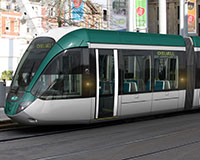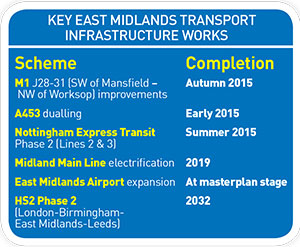Last month Sir Albert Bore and Jon Collins, leaders of Birmingham and Nottingham city councils respectively, wrote to transport secretary Patrick McLoughlin asking him to support a pan-regional entity created this summer.
Midlands Connect is a platform, promoted by the main LEPs and local authorities in the East and West Midlands, which aims to unite transport infrastructure under a single umbrella. Its stated aims include: improving east-west connectivity across the Midlands, strengthening the freight corridor and opening up land for commercial and residential development.
Midlands Connect has some local communications work ahead of it as the property community in the East Midlands is largely unaware of its existence and objectives. One agent, who declined to be named, reasons: “The level of competition between UK centres means Nottingham, Derby and Leicester find it hard to work together – so getting them to cosy up to Birmingham will be very hard indeed.”
While Midlands Connect puts together a strategic investment plan this autumn, work is already under way on a number of transport schemes in the East Midlands, totalling more than £1.4bn, many of them centred on Nottingham (see boxes).
“Unfortunately all of the improvements have been going on at the same time. While that will be great in the long term, it’s been a pain for everyone working in the city over the past couple of years,” says Tim Garratt, director at East Midlands agency Innes England.
The most disruption has come from the extension of Nottingham’s tram lines. Matt Smith, lead director of JLL’s Nottingham office, says: “Phase two of Nottingham Express Transit is much more of a game-changer from an occupational perspective than the original line. The new routes connect businesses and the massive employment hub of QMC (Queens Medical Centre) with the city centre and opens up new opportunities. It will certainly influence decision-making for tenants.”
He adds that increased provision of city-centre residential accommodation could boost flows out towards NG2, MediPark and QMC. Mark Bielby, development director at Miller Birch, developer of NG2, where around 175,000 sq ft on nine acres remains to be built out, certainly welcomes the new transport link.
“It will inevitably benefit sites along the route and connectivity between business nodes and the academic centres,” he says.
What remains to be seen is whether the new lines divide property values into two tiers, depending on how close a site is to the tramway. Anecdotal evidence suggests values of land and property near tram stops were boosted by up to 15% when the original line opened in 2004.
Nottingham, as well as Leicester and Derby, is expected to benefit from the electrification of the Midland Main Line in 2019. Property agents maintain that’s too far in the future to affect decisions being made by office occupiers now. But Marketing Derby managing director John Forkin says the renaissance in major rail projects across the country could have a positive spin-off for Derby. “The city has the largest cluster of rail-related companies in the UK. People tend to think of manufacturing, but actually these days they are mainly technology companies.” He believes that the 100-plus specialised businesses, which include Interfleet, Porterbrook, Angel Trains and Delta Rail, will encourage others to locate in the city. New arrivals will help take the sting out of a government decision last month to locate the proposed College for High Speed Rail in Birmingham and Doncaster, rather than Derby, which was on the shortlist.
Net2: More trams for Nottingham
Next summer Nottingham trams which have, since the network opened in 2004, terminated near the main railway station, will for the first time run through the city centre, when new extensions are opened to the south and south-east of the city.
Line 2 will run to a 1,000-space park & ride facility at Clifton, off the newly widened A453 (see box), while Line 3 will head through Beeston to a park & ride facility at Chilwell, close to junction 25 of the M1. The £570m second phase of NET (Nottingham Express Transit) will add an additional 11 route miles and 28 new tram stops, providing up to 16 services an hour in each direction.
Annual passenger numbers are expected to increase from 7.9m in 2013 – the new routes will increase capacity to 23m. Nine route additions and extensions have been identified, but none are at an advanced stage.
One of the most likely candidates is an extension of Line 3 from Chilwell to the proposed East Midlands Gateway station at Toton, to be built as part of the second phase of HS2.
Road
Recent and current road improvements are centred on Nottingham, which has seen widening of the city’s ring road. Work is taking place to widen the A453, a well-known pinch point on a seven-mile stretch between the A52 at south Nottingham and junction 24 of the M1 that has been struggling to cope with a daily throughput of 30,000 vehicles. The £150m Highways Agency project, which started on-site at the beginning of 2013, is due to complete next spring, and provides a link to the new Clifton park & ride facility for the extended tram network (see box).
The Highways Agency also started on-site works this summer on a £225m scheme to turn a section of the M1 between junctions 28 and 31 into a ‘smart motorway’, by converting the hard shoulder into an extra lane and introducing variable speed limits to control the 95,000 vehicles that pass through each day. When the work concludes next year a substantial reduction in congestion is expected.
Rail
Network Rail’s £150m major refurbishment and resignalling of Nottingham station was largely completed this year, following a complete shut-down for six weeks last summer. The new layout includes a new platform, better accessibility for pedestrians and has resulted in journey time reductions on some London services. The tram network, which for the past decade terminated on a viaduct close to the station, will be directly connected to it when a new bridge opens next year as part of the NET2 expansion.
The work at Nottingham means the station is now ready for electrification, part of the £500m Midland Main Line scheme announced in 2012, that will connect the wires from London’s St Pancras, which now stop short at Bedford, and extend them through Leicester to Nottingham, Derby and Sheffield. Earlier this year the contract for the work was awarded to Carillion and the first electric through trains are expected to run in 2019, slicing up to a quarter of an hour off journey times.
Further off, the second phase of HS2 is due to reach the East Midlands hub station at Toton, between Derby and Nottingham, in 2032.
East Midlands Airport expansion
Earlier this year East Midlands Airport, part of Manchester Airport Group, produced a sustainable development plan, setting out growth prospects to 2040. The plan acknowledges that forecasts made during the economic boom were wide of the mark, but still believes that there is potential to significantly increase annual passenger numbers, now 4.3m, and freight carried, at present 300,000 tonnes. The airport is the largest employer in Leicestershire (6,700 people) and generates £279m annually to East Midlands’ GVA. Around 25 acres remains to be developed at the airport’s Pegasus Business Park. The next phase of building at the park is understood to be on the drawing board, though it is likely to target airport-related occupiers.












